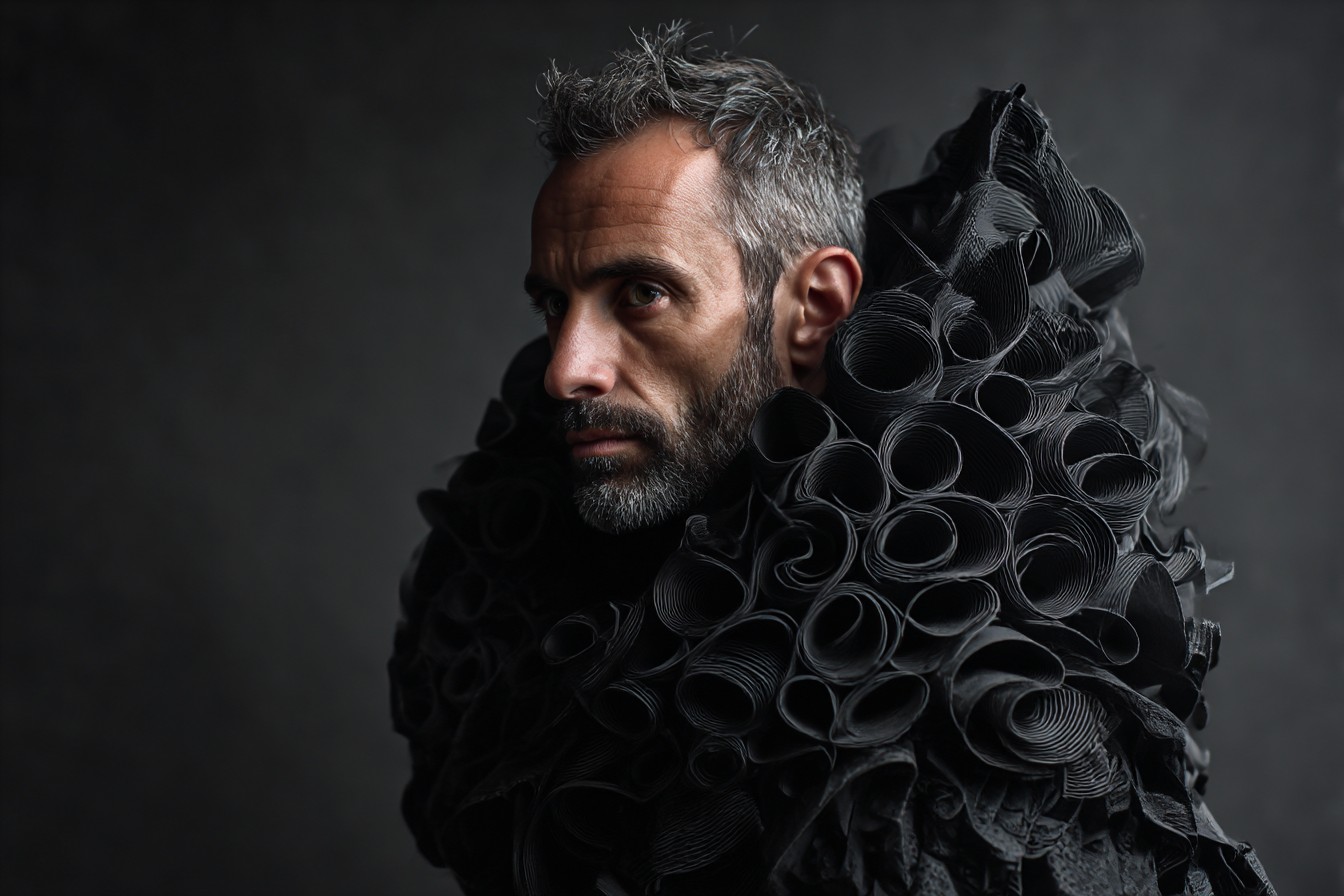I killed a t-shirt last week. Not like, “oh this doesn’t fit right anymore” killed it. I mean I put it on, raised my arms to grab a coffee mug from the cabinet, and the entire right seam split open like I was auditioning for an off-Broadway production of The Incredible Hulk. The shirt was from one of those fast fashion retailers I won’t name (but rhymes with “shmeverlane”), cost about $15, and had survived exactly seven wears and three washes.

Standing in my kitchen, now essentially wearing half a shirt and feeling the cold air on my exposed ribs, I had to reckon with an uncomfortable truth: I, a supposed menswear expert who literally gets paid to have opinions about clothes, had been suckered by the siren song of cheap, trendy crap. Again.
And look, I get it. The temptation is real. When you can get an entire outfit—shirt, pants, even a jacket—for less than what a quality pair of shoes would cost, the math seems simple. Especially when these clothes often look pretty damn good… at first. They’re designed to hit that initial dopamine rush of “new clothes feeling” without any consideration for what happens three washes later.
This pattern used to define my early twenties. I’d blow my meager editorial assistant paycheck on whatever trendy items I saw in the windows along Broadway, wear them a handful of times, and then watch them disintegrate, pill, fade, or warp into unwearable shapes within months. It was a cycle that felt affordable in the moment but added up to thousands of dollars literally thrown in the trash.

The wake-up call came when I was helping my mom clean out my childhood bedroom and found a J.Crew oxford shirt my dad had handed down to me in high school. Ten years and countless washes later, it looked better than stuff I’d bought six months earlier. The fabric had softened beautifully, the collar still stood properly, the buttons were all intact. Meanwhile, the “premium” fast fashion button-down I was currently wearing already had a weird bacon-collar situation happening after just a few months.
That’s when it clicked: I wasn’t saving money with cheap clothes. I was wasting it.
But here’s the thing—the alternative doesn’t have to be dropping $400 on a shirt or only shopping at luxury boutiques that offer you sparkling water while you browse. There’s this sweet spot of brands and items that cost just a bit more than fast fashion but deliver exponentially better value. These are the clothes that, amortized over their actual lifespan, end up being cheaper per wear than almost anything else in your closet.

Take t-shirts, for instance. I used to buy packs of them for $10-15 each, replacing them every few months as they twisted into weird crop tops after washing. Then a stylist friend introduced me to a small American manufacturer making tees for $30. “Thirty bucks for a plain t-shirt? Are you high?” was my initial reaction. But these shirts are still in my rotation four years later. The math is clear: six cheap $15 shirts replaced twice a year for three years = $180. Three good $30 shirts that last three years = $90.
This principle applies across basically every category of menswear. Everlane’s $68 chinos might seem steep compared to H&M’s $25 version, but when the H&M pair bags out at the knees and fades unevenly after a month while the Everlane pair stays sharp for a year, you’re actually spending more on the “budget” option.
My friend Trevor—yes, the one whose dad works for Hugo Boss, he’s still insufferably well-dressed—calls this the “fake broke tax.” It’s the premium you pay for thinking you’re saving money when you’re actually spending more in the long run. And the worst part? You don’t even look good while paying it.

So where are these magical middle-ground brands that offer the best quality-to-price ratio? I’ve spent years finding them through trial, error, and more blown-out seams than I care to admit. Here’s what I’ve discovered:
For basics like t-shirts, underwear, and socks, brands like Uniqlo’s Supima cotton line, Asket, and Kotn offer quality that rivals luxury brands at prices just slightly above fast fashion. The $15 vs. $30 t-shirt example isn’t theoretical—that’s the actual price difference, and the longevity difference is real.
When it comes to denim, the sweet spot is usually between $80-150. Brands like Naked & Famous, Nudie Jeans, and even Levi’s Made & Crafted line occupy this territory. The jump in quality from a $40 pair to a $100 pair is massive, while the difference between a $100 pair and a $300 designer pair is often minimal for anyone who isn’t a denim obsessive.

For button-up shirts, I’ve found brands like Spier & Mackay, Charles Tyrwhitt (when on sale), and even J.Crew (again, on sale—never pay full price there) offer substantial quality around the $70 mark. These shirts will last years rather than months.
Footwear is where this principle becomes most obvious. The gap between a $100 shoe and a $200-300 shoe is the difference between replacing them annually and resoling them after five years. Brands like Meermin, Thursday Boots, and Grant Stone occupy this middle territory where the construction quality takes a quantum leap without the price doing the same.
The trick is recognizing when spending more actually gets you better quality versus when you’re just paying for marketing or designer prestige. Some guidelines I’ve developed:

Check the fabric weight. Heavier doesn’t always mean better, but substantial fabric is generally a good sign, especially for items like shirts and pants. If something feels flimsy in your hands, it will look flimsy on your body.
Examine the stitching. More stitches per inch generally indicates better construction. Reinforcement at stress points is crucial—that’s actually what failed on my split t-shirt.
Look at seam finishing. Raw, unfinished seams are a red flag at any price point. Clean, flat seams that don’t twist or bunch are worth paying extra for.

Research construction techniques. Welted shoes can be resoled, extending their life indefinitely. Jeans with selvedge outseams tend to hold up better to repeated washing. Shirts with pattern matching at the seams indicate attention to detail that correlates with overall quality.
I’m not suggesting you need to become a textile engineer or spend hours researching every purchase. But developing a basic understanding of quality markers will save you thousands over time. And honestly? It’s kind of fun to become the guy who can spot good construction at thirty paces. My friends now send me photos from dressing rooms asking for quality checks, and I feel like some kind of clothing psychic telling them, “Those seams will fail within a month” (I’m usually right).
The other approach is to simply look at brands operating in that middle territory where they’re focused on materials and construction rather than trend-chasing or logo placement. Some consistently reliable options include:

Taylor Stitch, whose $125 shirts and $150 pants are built like tanks but look refined.
Buck Mason, with basics that cost maybe 30% more than Gap but last 300% longer.
Universal Works, offering workwear-inspired pieces with excellent fabric sourcing.
Portuguese Flannel, making shirts that rival ones three times their price.
Reigning Champ for sweatshirts and casual wear that actually gets better with age.
These aren’t exactly budget brands, but they’re accessible splurges that pay dividends. Save up for one good piece instead of three disposable ones.
Another strategy? Be patient and shop the sales. That $150 jacket might hit $75 at end-of-season, at which point it’s competing with fast fashion prices while offering substantially better quality. I’ve built probably 60% of my wardrobe this way—buying better brands at deep discounts rather than cheaper brands at full price.
The most sustainable clothes—both environmentally and financially—are the ones you don’t replace. My closet now contains fewer items than it did five years ago, but they’re better made, more versatile, and ironically cost me less annually because they don’t need constant replacement.
That doesn’t mean I never buy from fast fashion retailers—I’m not made of money, and sometimes you need something specific for a one-time event. But I’ve learned to be strategic about it. If it’s a core piece I’ll wear regularly, I spend more upfront. If it’s a super-trendy item that might look dated in six months, maybe that’s where I’ll go cheaper (though vintage/secondhand is often even better for trend experimentation).
The final piece of this puzzle is care. Even well-made clothes will fail if treated poorly. Washing cold, hanging to dry when possible, folding knits instead of hanging them, using shoe trees—these habits extend the life of everything in your wardrobe, making even moderately priced items perform like luxury ones.
My split-seam t-shirt incident became a moment of reckoning. I gathered all the fast fashion in my closet, assessed what was already showing signs of wear, and made a plan to gradually replace those items with better versions as they fail. It’s not about overnight transformation—it’s about shifting your default settings over time.
Last month, I splurged on a $68 waffle henley from a small American manufacturer that specializes in heavyweight knits. It replaced a similar $25 version that had already started unraveling at the cuffs after just four wears. When I mentioned the price to my dad on our weekly call, he did his usual “you paid WHAT for a shirt?” routine. I just smiled and told him to ask me again in five years when I’m still wearing it.
The cheap shirt is gone. That money is gone too. The slightly more expensive, significantly better shirt will be with me for years. In the long game of looking good while managing money, that’s what victory looks like.



